|
13 October 2014
Stephen
M. Apatow
Biomechanics
Specialist & Technical Consultant
Founder, Director of
Research & Development
Sports Medicine &
Science Institute
International
Dancescience Development Program
Phone: 203-668-0282
Email: s.m.apatow@edancescience.org
Internet: www.edancescience.org
Faculty: Nutmeg
Conservatory for the Arts
Facebook: edancescience
Nominated:
International Dance Council (UNESCO)
United Nations Arts
Initiative
Internet: www.unarts.org
Centers
for Disease Control called to require proper stretch and flexibility
training before every classical ballet technique class
Classical ballet
training is
recognized as the most advanced technical movement mechanics training
in the world. The biomechanical ideal in training, represents the
most
stable, balanced, integrate relationship of the spine and
extremities
for injury prevention, advanced sports
medicine treatment and performance optimization. The
International
Dancescience Development Program emphasizes the importance of education
and training in classical ballet based biomechanics and orthopedic
analysis for the medical community.
For
many years, the
importance of classical ballet specific flexibility
and
alignment training has been emphasized for dance education programs.
In classical ballet (the foundational training for all styles
of
dance), training is executed in a turned out
alignment,and requires specific stretches that must be integrated
into the pre-class warm-up. Unfortunately this guidance is many
times
ignored, at a cost of progressive
joint
stabilization and deformities in childhood development, that make
correct
postural alignment a virtual impossibility, and follow the student for
a lifetime. See:
Education:
Recommendations
Classical
Ballet Specific Stretch & Flexibility Exercises
Introduction
A recent article in Dance Magazine "What Are They Doing Wrong?" [1]
mentioned the topic of dynamic vs static stretching before the
classical ballet technique class. The first thing that came to my
mind was the range of motion or flexibility required to work with
correct alignment, during each progressive exercise in a classical
ballet technique class.
See, in classical
ballet training, incorrect alignment in a development program (that can
begin in some cases at 3-5 years of age), will shape the bone growth
patterns and articular development, that can last a lifetime.
Only perfect practice
makes perfect.
– Vince Lombardi.
Today, I present this topic as an Olympic development athlete [2,3] who
entered classical ballet training in my early 20's, with no dance
background. Training through scholarships, I was thrust directly
into advanced dance classes, in an effort to optimize postural
alignment for sports specific training. 3 years into this
adventure, I moved from a modern, Jazz and ballet, [4] to training at
the Nutmeg Conservatory for the Arts. [2] By the time I reached
Nutmeg, the combination of a sports medicine background and hard work
helped me develop the foundational flexibility required for advanced
classical ballet training.
This meant, as a 20 year old, I was able to change my body, enhance my
flexibility, bone and articular level stability and function. The
importance of this story, for youth at all ages who are pursuing
excellence in classical ballet training,
is that
there is hope with hard work, in an objective to reach your own
personal potential in the most advanced technical movement mechanics
training in the world.
Hip Range of Motion: Turnout

|
In the turned out position, the weight should fall from the
body to the thigh and directly through the knee and
ankle. This distribution of weight can be achieved if the
external rotation of the lower extremities occurs at the hip.
As a rule, external rotation of the foot should only occur to (1) the
mechanical ability to track the knee cap over the center line of
the ankle and foot and (2) the center of gravity (vertical axis) 2
inches behind navel, dropping between the heels (1st, 2nd, 4th, 5th).
|
Today,
Pilates
and Yoga are a popular focus for cross training in many ballet
programs. These programs are tremendous, as are a broad range of
dance disciplines, such as modern, jazz and tap. But in a
classical
ballet development program, it is critical that classical ballet specific flexibility and strength are
developed to optimize, not impede progress.
If we stretch and
strengthen the body in a parallel alignment, the body is trained to
work in parallel. This contributes to the challenge of
classical ballet dancers working with parallel alignment, or turnout
below the knees.
The
following classical ballet specific stretches, target flexibility and joint range of
motion objectives, that need to be achieved before every classical
ballet technique class.
The Turnout Stretch
After a slow progressive warm-up, the turnout
stretch should be executed slowly, below a threshold of discomfort.
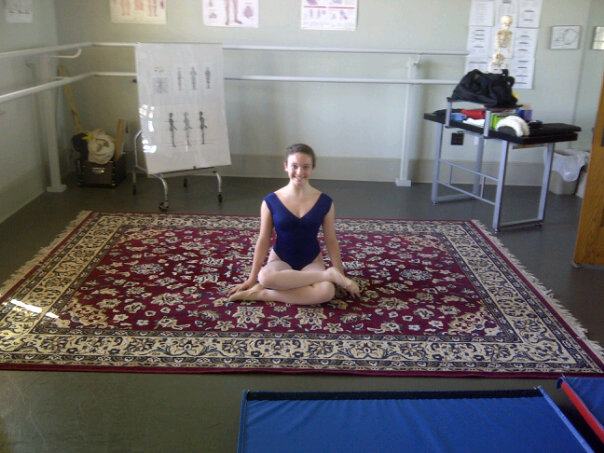
Photo Credit: Sports
Medicine & Science Institute, 2013.
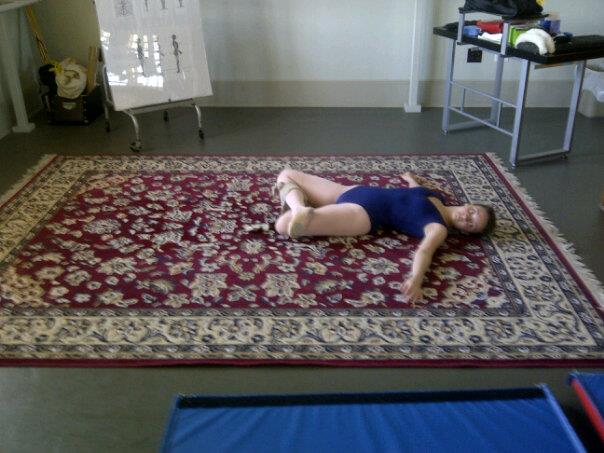
Photo Credit: Sports
Medicine & Science Institute, 2013.
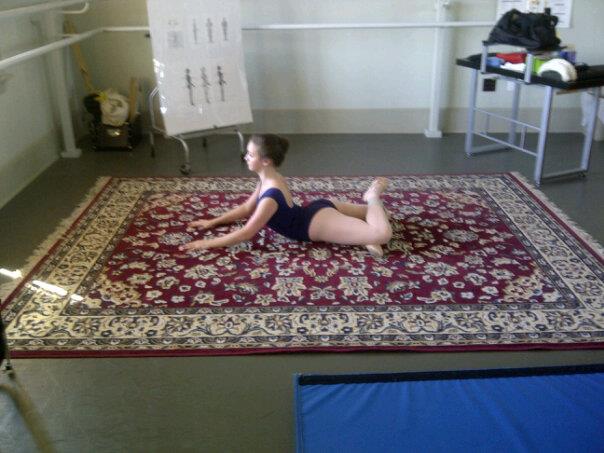
Photo Credit: Sports
Medicine & Science Institute, 2013.
The
Lower legs are positioned at 90 degrees, ankle on top of lower leg (do
not sickle foot). From a seated position stretch forward, flat
back. As the turned out femur moves toward the center line, or an
over-crossed position, this represents your front extension toward 135
degrees (in regards to a turned out upper leg). Lying back
encompasses your range of motion in a standing turned out
position. Again, as the turned out upper leg moves toward the
centerline, this represents your 5th position.
This stretch is your reference point for the degree of turnout that is
being executed below the knee, if you are working from a fully turned
out position in technique class. If the upper leg only turns out to 45
degrees, then your alignment reflects a dancer with 45 degree turnout,
even if you have perfect turnout below the knees. Our objective is to be working to the
fullest of our personal potential, with correct classical ballet
alignment
Note:
In the seated turnout stretch, the upper leg
can be stabilized with a wrap or a Thera-Band, to assist the slow
progressive stretch
into the lying back position.
All exercises need to be done slowly and below a threshold of
discomfort.
Incorporating
turnout into functional extensions
The objective to
achieve a fully turned out front split, begins from the upper leg. The
goal is to keep the hips square, with attitude (90 degrees lower leg),
front and back, working progressively toward alignment of each fully
turned out leg, through the centerline of the body.
From the attitude
position, each leg is extended maintaining full rotation of the upper
leg. Please note the difference between a fully rotated extended leg,
and a parallel extended leg.
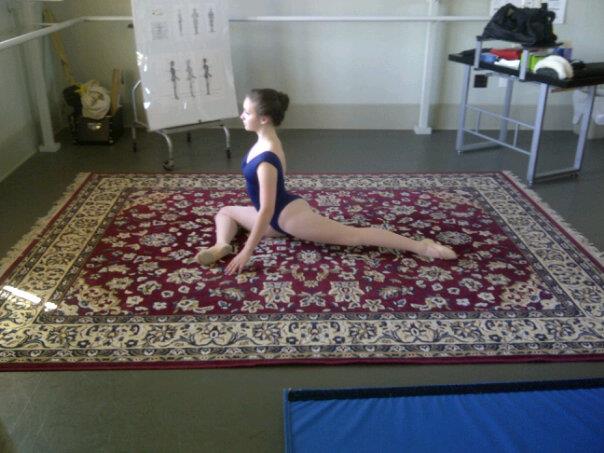
Photo Credit: Sports
Medicine & Science Institute, 2013.
Be sure to work with
correct classical ballet alignment, in each position and remember "If
you can't execute correct alignment on the floor, you can't execute
correct alignment at the barre."
Grand
Rond de Jambe en l'air at 90 degrees
The following stretch
sequence focuses on the range of motion required to execute Grand Rond
de Jambe en l'air at 90 degrees.
Hips
square, allowing pelvis to stretch toward the floor, with a fully
turned out leg in the arabesque position. In the front split, each leg would
extend with full turnout or upper leg rotation.
 Photo Credit: Sports
Medicine & Science Institute, 2013.
Photo Credit: Sports
Medicine & Science Institute, 2013.
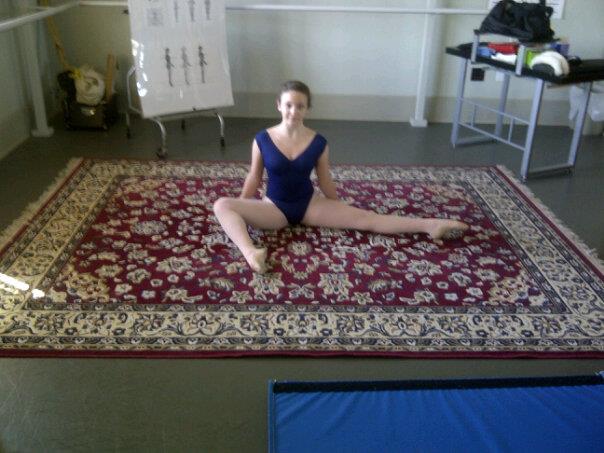
Photo Credit: Sports
Medicine & Science Institute, 2013.
Hips
square, extend the back leg to arabesque, then rotate the leg through
to the a la seconde position. Smooth
transitional movement encompasses the range of motion needed for grand ronde de jambe en'lair at 90 degrees.
As a strength exercise, when warm, lift the leg off the ground (arabesque, a la seconde) and hold it there through the
sequence.
The
next sequence is extension of the
legs into the a la seconde or straddle split, flat back
forward working toward legs at 180 degrees. The next sequence is
rotation through the hip complex, through the front split (hips square)
on both sides.
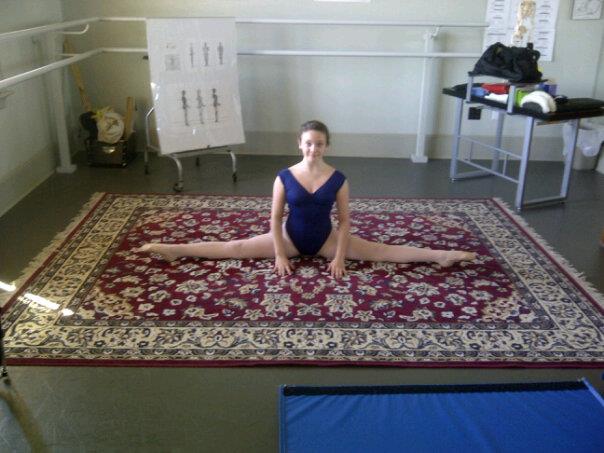
Photo Credit: Sports
Medicine & Science Institute, 2013.
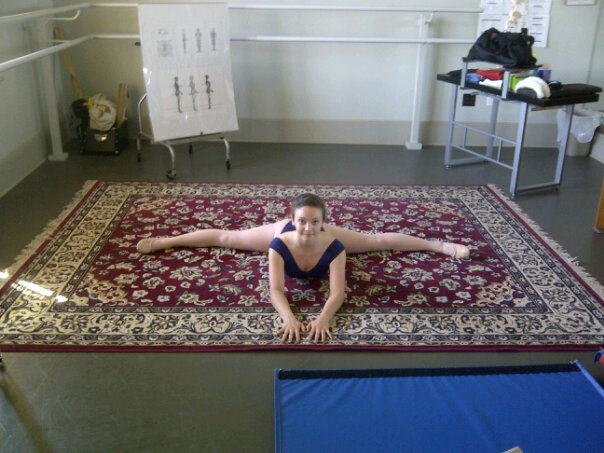
Photo Credit: Sports
Medicine & Science Institute, 2013.
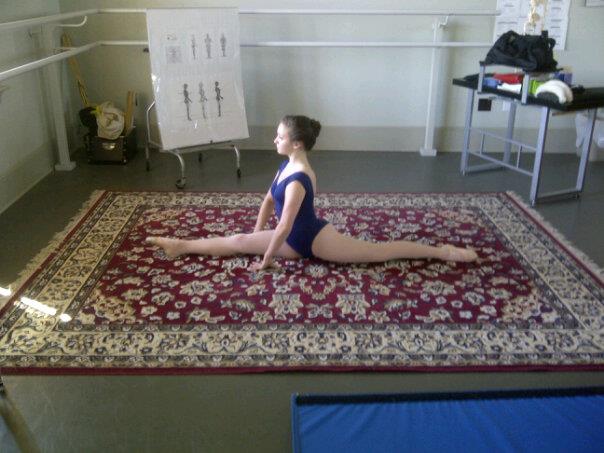
Photo Credit: Sports
Medicine & Science Institute, 2013.
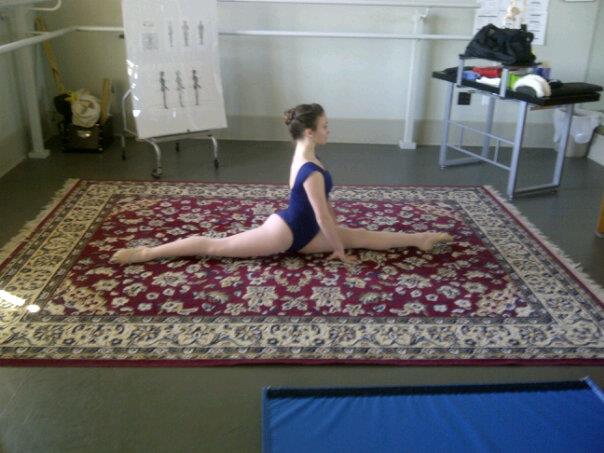 Photo Credit: Sports
Medicine & Science Institute, 2013.
Photo Credit: Sports
Medicine & Science Institute, 2013.
Alignment of
the Shoulder Complex
Postural
alignment of the shoulder complex is one of the most neglected areas,
second to hip turnout, in classical ballet training.
Correct
upper extremity alignment is demonstrated when (1) the shoulder complex
is held back and down, (2)
head of the humorous stabilized as far behind the clavicular head as
possible, (3) major muscle groups include concurrent contracture of the
pectoral and latissimus muscles to stabilize the shoulder complex and
stercliedomastoid muscle in the neck.
This
alignment will result in a flat
back position (non-winged scapulas) in port de bra
positions,representing the optimal alignment and connection of the arms
to the upper extremity.
Shoulder
Stretch
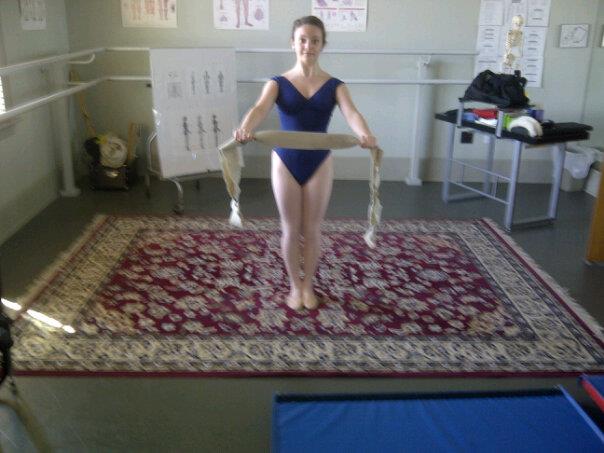
Photo Credit: Sports
Medicine & Science Institute, 2013.
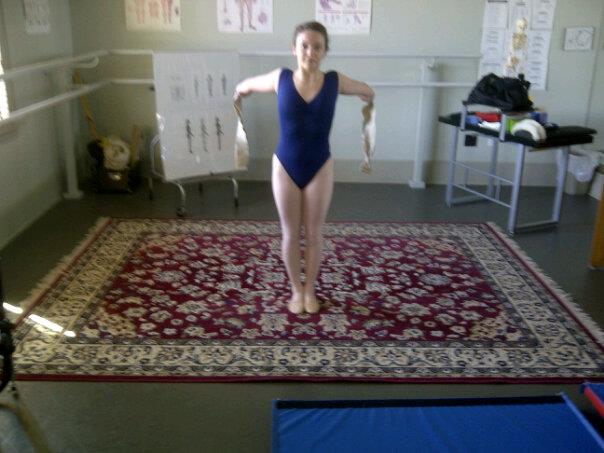
Photo Credit: Sports
Medicine & Science Institute, 2013.
Range
of motion of the shoulder complex is crucial for correct alignment of
the upper extremity. Holding a rigid band, rope or pole, position
the hands wide enough (elbows rotated up in port de bra position) to allow a smooth transition
overhead. As the range of motion
opens, bring the hands closer together. The arms must be held straight,
all movements executed with correct alignment.
Note: Olympic swimmers possess close
to the mechanical ideal, demonstrating full functional range of motion
of the shoulder complex. For dancers, Swan Lake or Swan Arms are a
great reference point for variant aesthetics.
References
1. What
Are They Doing Wrong?: Dance Magazine, July 20102. Url:
http://www.dancemagazine.com/issues/July-2012/What-Are-They-Doing-Wrong
2.Joint
Health - The Evolution of Classical Ballet Based Biomechanics:
UNArts: International Dancescience Development Program, 16 July 2012. Url:
http://edancescience.org/ref/jointhealth7162012.html
3. Nutmeg
Nuggets: Staying in peak condition: Register Citizen,
Torrington,
Connecticut, 13 June 2012. Url:
http://www.registercitizen.com/articles/2012/06/13/entertainment/doc4fd95a51ebe28806466056.txt
4. Lee Lund
Dance Studio: Url: http://www.theleelundstudioofdance.com/faculty.html
Selected Bibliography
Agrippina
Vaganova, Basic Principles of Classical Ballet, Dover, 1969
Alfred
A Knopf, The Classic Ballet, New York, 1984
Clinics
In Sports Medicine, Injuries to Dancers ,Saunders
1983
White-Panjabi,
Clinical Biomechanics of the Spine, J.B. Lippincott, 1978
Rosse-Clawson,
The Musculo-Skeletal System in Health and Disease, Harper & Row,
1970
Stanley
Hoppenfeld, Physical Examination of the Spine and
Extremities, Appleton, 1976
###
Stephen M.
Apatow
Founder of
Humanitarian Resource Institute (UN:NGO:DESA), United Nations Arts
Initiative, Pathobiologics International, and Sports
Medicine & Science Institute
International Dancescience Development Program.
Connect on LinkedIn
Sports
Science: Professional and Academic Experience
includes:
- Academic:
Exercise Physiology, Sports Medicine, Sabbatical 1984.
- 1984-90:
Full time training for ultra distance running, ultra-distance cycling,
national & international level competition in cross country skiing
and rowing.
- 1985:
Accepted to the national development camp for cycling, Olympic Training
Center, Colorado Springs, Colorado.
- 1986-89:
Through the help of Tony Johnson, heavyweight rowing coach at Yale,
began cross training sweep rowing and sculling with the New Haven
Rowing Club.
- Studied
modern, jazz and ballet training at the Lee Lund Academy from 1985-88
and the Soviet System of Ballet Training at the Nutmeg Conservatory for
the Arts from 1986-89. Graduate of the Nutmeg Conservatory for the Arts
Professional Program in 1989.
- 1987:
Presentation at Rossignol Cross Country Ski Clinic, speakers included
Bill Koch and Lyle Nelson coordinated by Mike Gallagher, (former
Olympian and Olympic Cross-Country Ski Coach), Mountain Top Inn,
Chittenden, Vermont.
- Martial
Arts: As a participant in the study of martial arts for over 20 years,
classical ballet training provided a scientific method (utilizing a
similar approach used in eastern bloc development programs) to optimize
speed, strength, leverage mechanics, force generation and technique.
Current training emphasis is Judo/Jujitsu. Founder: JudoSport
International.
- Technical
consultant for Cheryl Madeux, Finalist, Lausanne International Ballet
Competition in 1990.
- Technical
consultant for U.S. National Team athletes from Harvard University,
members of World and Olympic Festival Teams. Sports applications
include professional football, national level wrestling, hockey
cross-country and downhill skiing, skating and martial arts.
- Speaker
at 1990 Coaches Association Meeting for Sport Canada at the Olympic
Complex in Ottawa, Canada.
- Upon
request, applications of the analysis correction and retraining
procedures to enhance the joint flexibility and technical performance
for classical ballet training have been applied to musculo-skeletal
disorders that include entrapment neuropathies, Scoliosis, Rheumatoid
Arthritis, Asthma, Fibromyalgia, Frederick's Ataxia and Multiple
Sclerosis. One of our cases with Rheumatoid Arthritis was submitted to
the National Arthritis Foundation Peer Review Board in 1990. Analysis
and corrective procedures have been adapted to help spinal herniations
for physicians at Yale Medical School.
- Small
animal veterinary application of human biomechanics procedures leads to
work with hundreds of horses in dressage, hunter-jumper and western
training programs. (See: Expanding Human to Veterinary Biomechanics
Applications)
- 1994-98:
Corrective procedures developed to enhance the technical ability of the
international level dancer in ballet were adapted into dressage and
hunter-jumper specific training programs for both horse and rider. This
work was formally introduced as an equestrian development program at
the USDF Adult Camp in Boise, ID in 1997. In 1998, the USDF Region V
Adult Camp in Jackson Wyoming provided USDF University Credit for the
lecture presentation on "Biomechanics and Structural Analysis of Both
Horse and Rider."
- 1999:
Presenter at Society of State Directors of Health, Physical Education,
and Recreation Annual Meeting, Boston, Massachusetts.
- 1999
- Present: Research and development of programs associated with the
optimization of classical ballet training, Olympic development programs
and specialized orthopedic applications.
- 2002
International Sports Science Association Fitness Therapist Review: The
Science and Practice of Rehabilitative Exercise integrate theory and
practice in the health care arena. This specialized field utilizes
information from the world of rehabilitation, pathology, functional
anatomy and physiology and blends it with the world of fitness training
dealing with aerobic conditioning strength training, skill development,
exercise progression and prescription for special population
groups.
- 2003:
"Optimization of Classical Ballet and Sports Development Programs"
workshop was introduced at the 11 state American Alliance for Health,
Physical Education, Recreation and Dance (AAHPERD) Combined Convention
on February 12, 2003 in Reno-Sparks, Nevada.
- Currently
on faculty at the Nutmeg Conservatory for the Arts, director of the
International Dancescience Development Program. Consultancy work
with all
sports and Olympic development programs continues through JudoSport
International, encompasses classical ballet based biomechanics training
through martial arts based technical skill development.
###
|